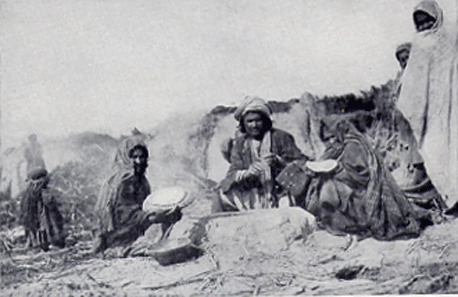
Baking bread in Seyistan on the Afghan Border
[It is hard to find a society in the Middle East without a thriving history of bread preparation. Before the modern loaf and bleached flour assaulted our tastebuds, a variety of flat breads were baked, either in clay overs or other makeshift ovens. Here is a description of both Afghan and Turcoman bread making from a century ago, as reported by Ellsworth Huntington in the National Geographic Magazine in 1909. Webshaykh.]
The method of cooking it was very different from that employed in the oases, where ovens of mud shaped like beehives, with a hole in the top, are heated with a fire of weeds, and the dough is stuck against the inside of the hot oven, where it hangs until it is so far cooked that it falls down into the ashes. The bread of the Afghan caravan was cooked by heating small, round cobblestones in the fire and then poking them out and wrapping dough an inch thick about them. The balls thus formed were again thrown into the fire to be poked out again when cooked. The bread tasted well there in the desert, although in civilized communities the grit and ashes would have seemed unendurable.
After good-fellowship had been established the Afghans actually sold us some flour. The camp where we used it a little later happened to be beside the sandy bed of a trickling salt stream, which was drinkable in winter, but absolutely unusable in summer, when evaporation is at its height and the salt is concentrated.
“See,†said one of the Turcomans, as we dismounted, “here is some sand, Tonight we can have some good bread.â€
When some dry twigs had been gathered he proceeded to smooth off a bit of the cleanest sand and built upon it a hot fire. When the sand was thoroughly hot he raked off most of the coals and smoothed the sand very neatly. Meanwhile one of the other men had made two large sheets of dough about three-quarters of an inch thick and eighteen inches in diameter. Between these he placed a layer of lumps of sheep’s tail fat, making a huge round sandwich. this was no spread on the hot sand, coals mixed with sand were placed completely over it, and it was left to bake. Now and then an edge was uncovered, and a Turcoman smelled it appreciatively and rapped on it to see if it was cooked. When the top was thoroughly baked the bread was turned over and covered up again. It tasted even better than the Afghan bread, after it had cooled a little and the sand and ashes had been whisked off with a girdle. The Turcomans are so accustomed to life in the sandy desert that they think it impossible to make the best kind of bread without sand, while the Afghans, who live in the stony mountains, think that cobblestones are a requisite.
Excerpt from Ellsworth Huntington, “The Afghan Borderland: Part II: The Persian Frontier,†National Geographic Magazine XX(20):876, 1909.